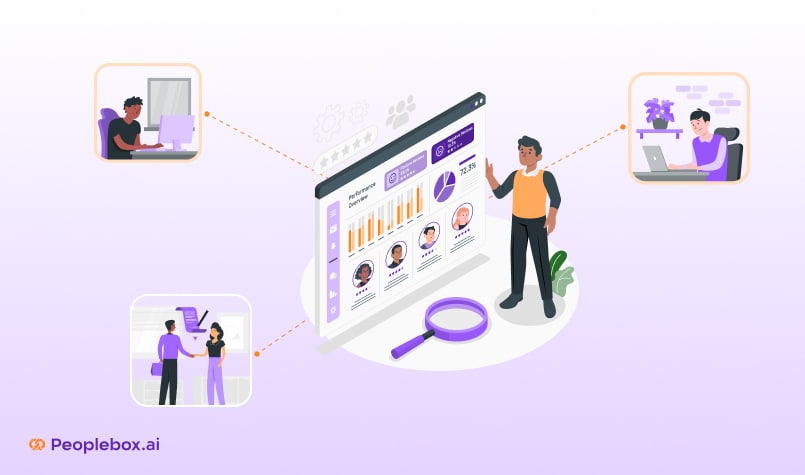The primary objective of a performance evaluation is to assess whether your employee’s performance is aligned with the bigger picture — your core business goals.
However, choosing inconsistent performance evaluation methods results in the following:
- Slow business growth due to unaddressed performance gaps
- Biased review results due to a lack of data-driven insight.
- Struggling HRs who have no benchmarks or context for performance.
- Demotivated employees who eventually leave due to no actionable development plans for their careers.
That’s why you need a robust employee evaluation plan in place. In this post, we’ll discuss the 12 best performance evaluation methods that enable you to:
- Make talent decisions based on reliable data.
- Conduct crucial conversations that drive growth.
- Create action plans for development to help employees upskill and be more efficient in their roles.
Setting up the right performance management evaluation method is just the beginning. For optimal results, you would also need a robust performance management platform like Peoplebox, which helps you effortlessly align goals, manage performance, and retain top talent. Try it yourself!
What are Performance Evaluation Methods?
Performance evaluations are periodic assessments that evaluate an employee’s job performance and contribution over a certain period. Often conducted quarterly or annually, these evaluations help managers measure and rate employees’ work quality, achievements, areas for improvement, and alignment with goals against predefined standards.
Why are Performance Evaluations Necessary?
Performance evaluations go beyond traditional appraisals. If you know what to look for, their benefits could be multi-fold.
Bridge Skill Gaps Over Time
Performance evaluations are meant to deliver data-backed, structured, actionable feedback.
Instead of waiting for annual reviews or delivering ad hoc, unstructured feedback, highlight the goals and objectives met by your employees throughout the year with the help of these evaluations.
Say you’re a sales manager. One of the skills you closely evaluate is how effectively your team explains the key benefits of your product during client demos and pitches. Recently, you noticed one of your sales reps struggling to communicate the value proposition of your software during an important client demo. He used too much technical jargon, got bogged down in niche features, and failed to tie capabilities back to client needs.
Since you have been continually evaluating employees, you have the data showing this was not a one-time slip but rather an emerging skill gap. Instead of waiting for the next formal review, you could use the latest evaluation insights to provide targeted coaching.
Peoplebox’s performance check-ins can take things one step further by helping you connect trends to underlying issues/improvements. Peoplebox can compile check-in ratings over time into graphical performance trends. This way, you can easily track progress on skill gaps. You can identify weaknesses, coach and develop employees in those areas, and then validate improvement through integrated performance visibility.
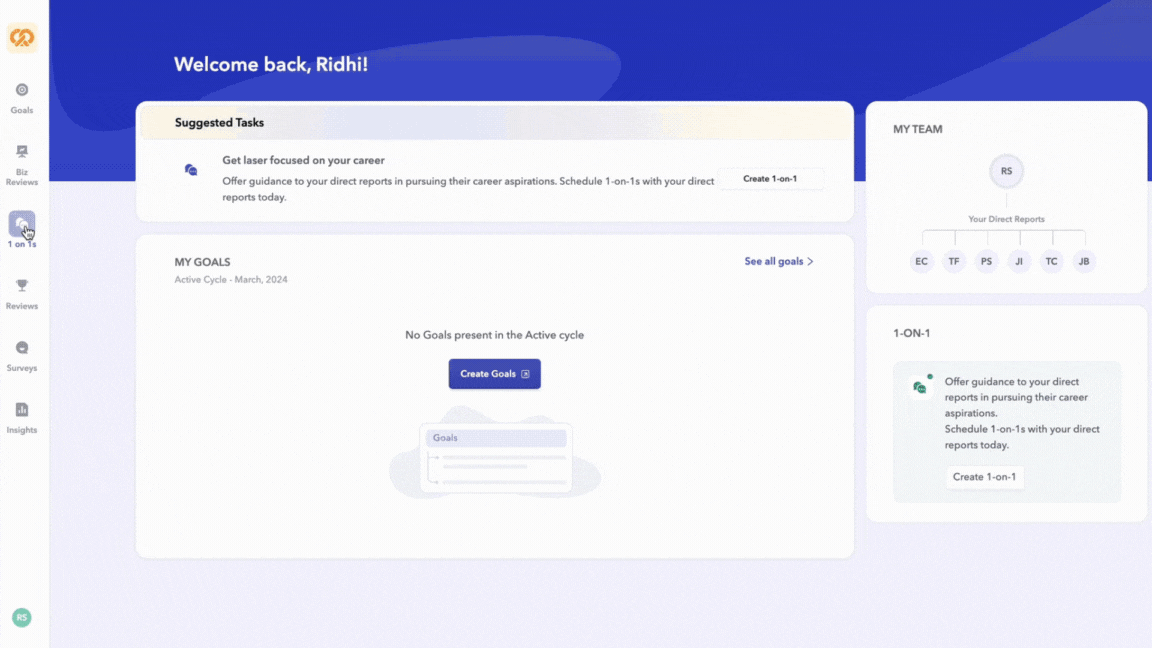
Change Long-Term Goals as New Talents Emerge
Your employees are constantly learning on the job. They may have outgrown the goals you set a year ago. Conducting performance evaluations makes sure that you’re changing objectives according to evolving skills instead of sticking to rigid goals.
Say you evaluate a lead software engineer this annual review cycle, and the data shows he consistently outperformed his peers against quality and timeliness metrics for code delivery over the past year. He also received outstanding feedback from teammates on collaboration.
Your evaluations show that he has exceeded expectations and therefore might have outgrown the goals you had set for him previously. He’s ready for a bigger challenge.
Similarly, evaluations quickly detect when a lower performer needs extra training before taking on more responsibilities. Place them on structured onboarding plans that build competencies before adding complexity.
Identify High-Potential Future Leaders Early On
Succession planning has long timeframes, typically more than 5 years, according to Forbes.
Performance reviews give you granular performance benchmarks that allow you to pinpoint and develop leadership traits much sooner than this.
Evaluating high-performers and assigning them more demanding work is a good way to know if they’re ready for more prestigious roles. You can leverage evaluation data to know when to transition them into more advanced roles instead of sticking to succession planning, which often follows a long, unchanging roadmap for employees. With Peoplebox, you can easily identify high-performers from within the platform thanks to its highly intuitive and customizable 9-box grid feature.

Performance evaluations can directly shape your employee’s work experience by making them feel recognized and providing growth opportunities, especially if you follow up with tangible development plans.
Employees also feel more invested when you tailor plans to help them flourish in their roles. They see firsthand how evaluations lead to impactful coaching, training, and job expansion. This powerfully fuels motivation, fulfillment, and dedication to high performance.
What are the Different Methods of Performance Management?
Now that you appreciate the multifaceted benefits, let’s equip you with the right performance management methodology tailored to your organization’s needs.
Management by Objectives (MBO)
This method involves setting specific, measurable goals with employees and then periodically reviewing performance toward these goals over a period. It creates transparency by linking evaluations directly to the objectives agreed upon by the manager and the employee. This also encourages adjustability as you can change the goals if situations change.
Management by Objectives (MBO) is time-intensive to create detailed objectives and maintain frequent progress discussions, and you also have to consider that the goals may not always capture all performance events. It is definitely harder to implement this method for jobs with undefined outcomes.
Here is how you can set up an MBO in your organization:
- Set your manager and employee up for a meeting to review past performance data. During this meeting, they can identify any issues or problems that occurred.
- Based on this, they can jointly decide on goals and objectives for the next performance period.
- Each employee receives their own tailored set of objectives and a specific timeline to achieve them.
- Make sure both parties meet regularly to discuss progress made towards goals and course-correct if needed.
- At the end of the performance period, managers conduct evaluations of employees based on the achievement of the predefined objectives.
When to use it
This method is useful in professional services, construction, and IT services where deliverables and milestones can be pre-defined. It can be used in high-growth startups where goals need to be flexible. It fits very well with businesses with a lot of quantitative goals.
Objective and Key Results
OKRs or Objectives and Key Results focus on stretch goals, or long-term goals, instead of incremental goals like MBO. The “objectives” part of the method sets ambitious goals for the employees. The “key results” part of the method focuses on shorter-term goals or metrics that help keep the employees on track with achieving said ambitious goal.
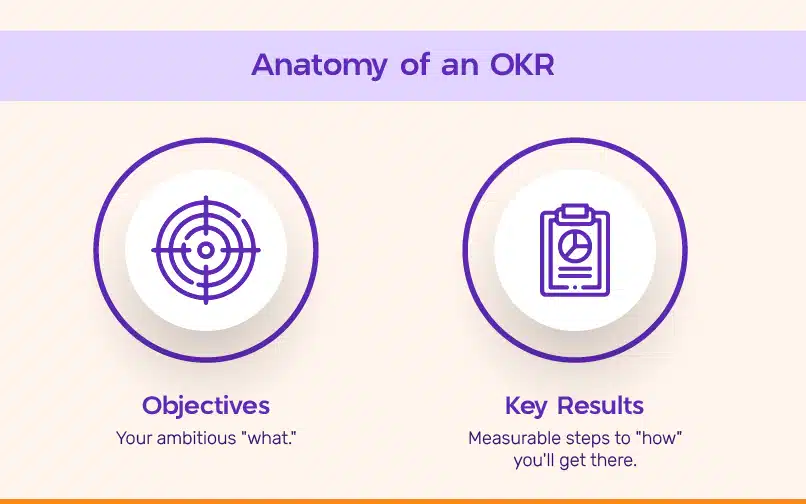
Simply put, the objectives define the qualitative aim while key results set quantitative targets essential to measuring achievement.
Though they sound similar, OKRs vastly differ from management by objectives. This is because OKRs operate on shorter cycles that allow for more adjustment, unlike management by objectives (which usually take place annually and are less responsive).
OKRs also focus on key results that assess the impact of an employee’s actions. This instantly tells you whether business goals are being met or will be made in the future.
OKRs are set collaboratively and made public across the organization so everyone can appreciate the big picture. It becomes easy for the employee to connect their day-to-day responsibilities with long-term business goals, increasing their focus and sense of purpose. This is why it is important to use an effective tool to showcase and track your OKR dashboards, like Peoplebox.
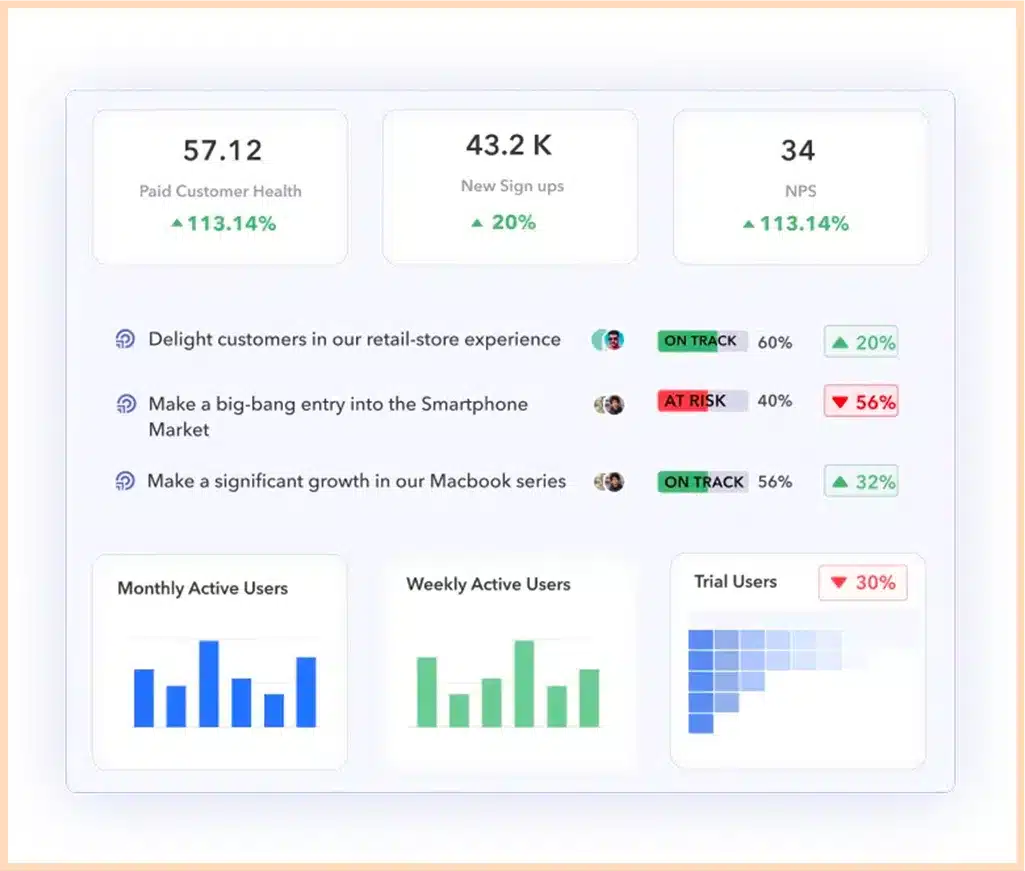
The other benefit of using OKRs is that it becomes easy for remote teams to feel aligned year-round with this method. It simultaneously allows for envisioning ambitious goals without forgetting about the smaller, tangible goals that you need to fulfill to get there.
Wondering what a good OKR looks like? Check out our blog post where we share 70+ OKR examples you can use for your teams.
Here is how you can set up an OKR in your organization:
- Begin by setting organizational objectives.
- Define quantitative key results tied directly to achieving these objectives. There should be typically 2-5 key results per objective.
- Upload the objectives and key metrics on your OKR dashboard.
- Begin monitoring the progress of these goals. You could be doing this every month and assess % completion towards key results.
- At specific intervals, evaluate your employee’s contribution based on OKR achievement.
- Identify progress and lagging indicators, and take action.
When to use OKR-based performance evaluation
Companies experiencing rapid growth or change align best through OKRs. Regular goal-setting and tracking routines help teams stay focused when priorities shift quickly.
Innovative organizations can use OKRs to set ambitious targets beyond normal capabilities. The transparency motivates teams to experiment in achieving big goals.
Distributed companies can use public OKR dashboards to ensure remote employees see the broader objectives and how their work contributes to them. This maintains engagement.
Here are four “Also Read” suggestions with hyperlinks for the blog on performance evaluation methods:
Suggested read: OKRs vs KPIs: What’s the Difference?
Tip: Use OKRs to focus on quantifiable key results tied to objectives rather than subjective assessments of the same objectives.
180-Degree Feedback
This method of performance evaluation involves the employee and their direct manager. Employees review themselves and are also reviewed and rated by the latter, offering a mix of self-evaluation and perspective.
New development areas are revealed in this feedback method, with weightage from both parties. This method also encourages employees to introspect as they evaluate their performances.
However, it’s important to use a performance management platform that makes it easy to track data. In the absence of one, using 180-degree feedback may lead to recency bias — as both parties will only have a memory of recent events.
With Peoplebox, managers can easily provide goal-focused feedback, ensuring data-driven evaluations and avoiding arbitrary assessments.
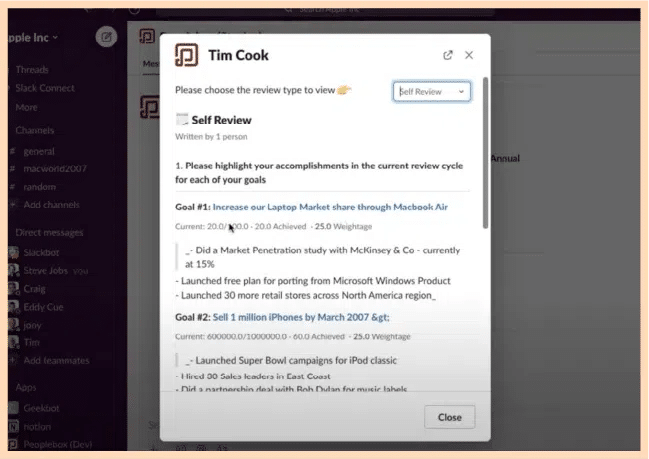
Here is how you can set up 180-degree feedback in your organization
- Design a 180-feedback survey questionnaire. This should include quantitative ratings and qualitative questions that are consistent across participants.
- Collect answers from the survey and review.
- Benchmark self-ratings to manager scores and analyze gaps and common themes.
- Review benchmarked scores and come up with a development plan together.
When to use it
You can use 180-degree feedback in any company, regardless of working style or size. It’s simple to set up and encourages discussion.
360-Degree Feedback
Another performance evaluation process is the 360-degree feedback method. You can get confidential feedback from all directions — managers, peers, and direct reports — with this method. The main aim of this method is to reduce bias and increase the scope of perspective.

It mitigates some of the bias that exists with 180-degree feedback, as you’re gathering feedback from multiple sources. Therefore, it gives you a more holistic view of the employee’s strengths and weaknesses. There are performance blindspots that the manager might have missed that can be identified with this method.
However, implementing this is time-consuming as it involves waiting for feedback from multiple stakeholders. You should also note that peer reviews may be biased in some cases, as they are often influenced by the employer’s working relationship with the employee and not an objective assessment of their capabilities.
Here is how you can set up 360-degree feedback in your organization
- Assign a process owner, typically from HR or Talent functions. This person will handle all communications and scheduling and serve as the point person for questions.
- Leverage existing feedback software if the company uses a performance management system. If not, select a purpose-built 360 tool.
- Schedule the feedback process and send calendar invites/reminders to participants.
- Ensure adequate time for the process — if the deadline is March, launch the process in early January.
- Collect feedback via surveys across four sources — self, manager, peers, and direct reports. Ask 360 degree review questions that matter.
- Analyze responses and look for gaps.
When to use it
You can use it when assessing employees in leadership roles across the organization. This also works well to assess performance in jobs where cross-departmental collaboration is key.
Suggested Read: 15 Best 360 Degree Feedback Software and Tools In 2024
720-Degree Feedback
This is an expansion of 360-degree feedback that includes additional sources such as clients, suppliers, or board members. This method is even better because it incorporates client perspectives, which are missing from the 360-degree feedback method.
The 720-degree feedback is a strong method to evaluate customer-facing competencies, as it quantifies areas of improvement from their point of view. There is even less bias as it involves parties that are not directly involved in the daily office routine and are not affected by office politics or existing biases. It can also open your eyes to what is visible to external stakeholders that you may have missed.
However, you’d have to assume longer wait times for so many stakeholders to synchronize the feedback for one employee. Collating the feedback once you have it can be overwhelming. If your employee works with clients on a retainer basis, and they submit very specific complaints that you choose to act on — it’s very likely the employee in question will be able to connect the dots to figure out who it is, compromising anonymity.
Here is how you can set up 720-degree feedback in your organization
- Follow the same steps involved in the 360-degree feedback process.
- Additionally expand the sources of feedback to include the employee’s clients, which could be internal (e.g. other teams within the company) or external clients.
- Conduct the first feedback meeting to discuss initial survey results and insights with employees.
- Hold a second follow-up meeting a few months later to review progress made by the employee on their personal development plan and make any course corrections.
When to use it
For customer-facing roles where getting client perspectives is critical and for senior leadership roles to evaluate company vision, alignment with market demands, and strategic decisions. Feedback from the board, investors, and partners can be invaluable for roles like these.
Critical Incident Method
The critical incident method documents employee behaviors in high-impact situations over time. Because you’d be logging behaviors over time, this method enjoys very little recency bias but is time-consuming to execute.
This is also a very qualitative method, which means the context you have for every feedback is high, but objectivity is not. The method largely depends on your interpretation of the incidents that take place and could discourage risk-taking behaviors which are essential for certain roles.
Here is how you can set up the critical incident method in your organization
- Record specific important situations, both positive and negative, and note how an employee handled the situation.
- Compile all the recorded employee behaviors over some time in an incident log.
- During annual appraisal meetings or regular one-on-one check-ins, review all the employee’s performance incidents with them over the evaluation period.
- Gather perspectives and facts about each high-impact incident from other team members also involved, if possible.
- Analyze the facts to pinpoint any issues or problems.
- Collaboratively determine solutions to mitigate those problems in the future.
When to use it
You can use this to evaluate individual performance in customer-facing roles where employee behavior carries consequences and jobs that require quick thinking and decision-making.
Checklist Method
This performance management methodology uses a predetermined checklist of metrics to evaluate employee performance. There are two main kinds of checklists. A developmental checklist and a demanding events checklist. A developmental checklist keeps track of skills and traits gained over time, while a demanding events checklist records important work milestones or situations that have stood out.
Because the performance criteria are outlined so minutely, the review process is bound to be standardized, with ratings being consistent. This method also makes it easy for you to outline the expected competencies and behaviors that every role carries. Since evaluators have to score employees on existing criteria, the data they collect is objective and easily comparable over time.
However, there’s a risk of fixating on the checklist rather than actual progress, potentially overlooking new beneficial behaviors. Additionally, this performance appraisal method lacks qualitative input, missing key contextual factors during evaluations, such as the origin of behaviors and justifiable reasons behind undesirable actions.
Here is how you can set up the checklist method in your organization
- Identify the most important performance criteria and competencies employees need to demonstrate for a given role. These form the topics on the checklist, some examples of which are:
- Meeting deadlines and timeliness
- Productivity and workload management
- Goal progress and achievement
- Job and industry knowledge
- Technical/hard skills and proficiency
- Communication skills
- Critical thinking and problem-solving
- Creativity and innovation
- Initiative and self-motivation
- Standardize a master checklist template that managers across the organization can use for evaluations.
- Create checklists in one of three formats: Simple yes/no answers, forced-choice type answers with predefined options to select from, or weighted checklists with numeric scoring scales.
- Include space for open-ended comments by reviewers to provide qualitative context justifying the rating on each checkpoint.
- Collect all checklist data and analyze results to identify strengths, weaknesses, and gaps across the workforce.
- Generate performance analytics reports and insights that managers can use for calibration.
When to use it
Since the checklist method defines behaviors well, is very applicable to metric-oriented roles.
For example, a CMO can create checklists to grade marketing managers on metrics like delivering campaign briefs a week before launch, incorporating requested feedback from stakeholders, and updating status reports bi-weekly.
Psychological Appraisal
This method leverages psychological tests and tools like personality and IQ tests to evaluate capabilities. They focus on future performance and capabilities instead of past performance.
The main strengths of this method lie in the in-depth analysis of traits it provides you with, uncovering core strengths and weaknesses in the process. Because most of this data can be quantified( for example, scores on intelligence and emotional quotient tests), it is easy to track and extract insights from. There’s also very little room for bias with this method, as the evaluations are conducted by qualified psychologists.
However, psychological appraisals are time-consuming to structure and may need to be customized for every employee. This makes it difficult to scale. Employees could also feel like their privacy is being invaded, as these evaluations go a lot deeper than analyzing work behaviors.
Here is how you can set up psychological appraisals in your organization
- Break down behaviors critical for success into core components that can be measured. These might include interpersonal traits, cognitive abilities, emotional intelligence, and leadership capabilities.
- Partner with a qualified psychologist who can design and administer a comprehensive set of psychological assessments.
- Conduct evaluations using situational scenarios to evaluate behaviors (e.g. handling an aggressive coworker).
- Psychologist presents detailed results to the employee and manager during an appraisal meeting.
- Leadership works with HR to create development plans and career progression paths based on psychometric evaluation insights.
When to use it
Use this to evaluate roles like managers, directors, and executives. The method spots potential and analyzes personality types for traits like leadership and dependency. It is a science-backed evaluation process to analyze high-potential employees who you want to advance into more senior roles.
Assessment Center Method
This method uses multiple evaluation tools and techniques through group exercises and simulations at a dedicated facility to evaluate employees over a longer period against pre-established criteria. It effectively evaluates leadership competencies through realistic simulations and mitigates bias by using multiple assessors.
However, developing a range of simulations for assessments is very expensive and might tempt you to place more importance on the simulation results than actual job performance.
Here is how you can set up the assessment center method in your organization
- Identify core leadership capabilities that assessments will measure – decision-making authority and strategic thinking.
- Design real-world simulations and group exercises that test competencies critical for the role.
- Partner with an external assessment center that can host activities over multiple days.
- Schedule employees to attend the assessment center in batches. Explain what to expect and the evaluation criteria.
- Observe behaviors during simulations and exercises, taking notes on strengths and development areas.
- Employees attend final feedback discussions with reviewers on performance.
When to use it
Use the assessment center method for roles focused on managing teams, processes, and operations. Since this method evaluates quick decision-making, use it for mission-critical jobs where this is a required trait. Senior leadership roles like executives will benefit from the insights this method will bring you.
Behaviourally Anchored Rating Scale
This method provides specific examples of effective and ineffective behaviors for each performance dimension.
You can then use these as “anchors” to rate overall performance. Rater subjectivity goes down as the behaviors are outlined. The method quantifies qualitative data, making it easy to set benchmarks for desired behaviors and remain objective about mostly subjective factors.
Behaviourally anchored rating scales may seem similar to the checklist method, but the latter primarily focuses on completed tasks, while the former focuses on core behaviors themselves.
However, creating the initial framework for this method is time-consuming, and the success of the evaluations depends on whether you have set the right anchors.
Here is how you can set up the behaviourally anchored rating scale in your organization
- Compile a list demonstrating effective and ineffective behaviors. Examples could be patience and quick thinking in the effective behavior category, and impatient and indecisiveness could be in the ineffective category.
- Link behaviors to performance results and impacts. Did your employee’s patience lead to happier customers after a service call? Did their indecisiveness lead to closing fewer deals, while a quick thinker closed more deals?
- Classify examples into scale with scores tied to behaviors.
- Match employee behaviors to levels on the scale.
- Employees are scored based on behavior-result alignment.
When to use it
The BARS approach could work for managers, leaders, and executives by tying leadership behaviors to team performance or business KPIs. For example, defining scales based on conflict management, change advocacy, or coaching.
Self-Assessment
In this method, employees complete their own appraisal process. This can include self-ratings across criteria and remarks which feed into formal evaluations. It encourages employee ownership over development and illuminates potential blindspots between manager and employee perceptions. However, this method can lack objectivity, as there is only one assessor.
Here is how you can set up self-assessments in your organization
- Employees conduct structured introspection on their performance.
- They complete standardized self-evaluation forms similar to peer reviews.
- Self-assessment includes objective ratings on capabilities, task achievement.
- Employees provide evidentiary support and examples for self-ratings.
- You review self-appraisals and discuss.
When to use it
The self-assessment method works best in businesses that rely on skilled individuals in charge of their goal setting, the ones completing specialized work independently. When experts have freedom over their tasks, managers cannot always fully see their strengths and weaknesses.
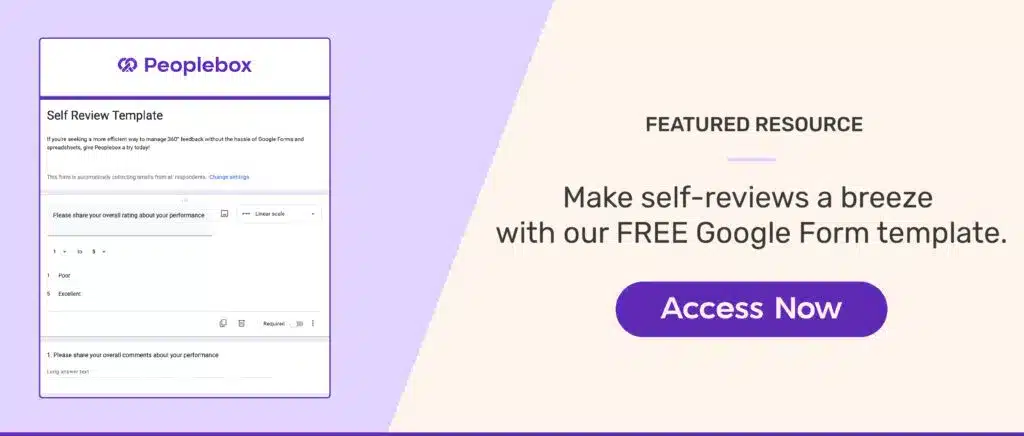
Peer Review
In a peer review, colleagues assess each other’s performance against set criteria during the review cycle. This provides additional perspectives that can be factored into appraisal decisions. This gives you more perspective beyond just manager insights which can be one-dimensional
We understand writing peer reviews can be daunting. To help your team, we have curated a list of peer review examples you can share with your team right away for an effective review cycle.
Here is how you can set up peer reviews in your organization
- Identify employees to be reviewed by their peers on skills critical to roles
- Select peer reviewers who work closely and can assess performance
- Create standardized review forms with performance dimensions and rating scales
- Peers complete reviews anonymously, providing qualitative feedback
- Managers aggregate feedback and data, discuss with employees in appraisal meetings
When to use it
Peer reviews are ideal for team-based organizations where collaboration is essential to achieving goals. Getting input from colleagues mitigates biases and provides well-rounded insights.
Peoplebox lets you conduct effective peer reviews within minutes. You can customize feedback, use tailored surveys, and seamlessly integrate it with your collaboration tools. It’s a game-changer for boosting development and collaboration in your team.
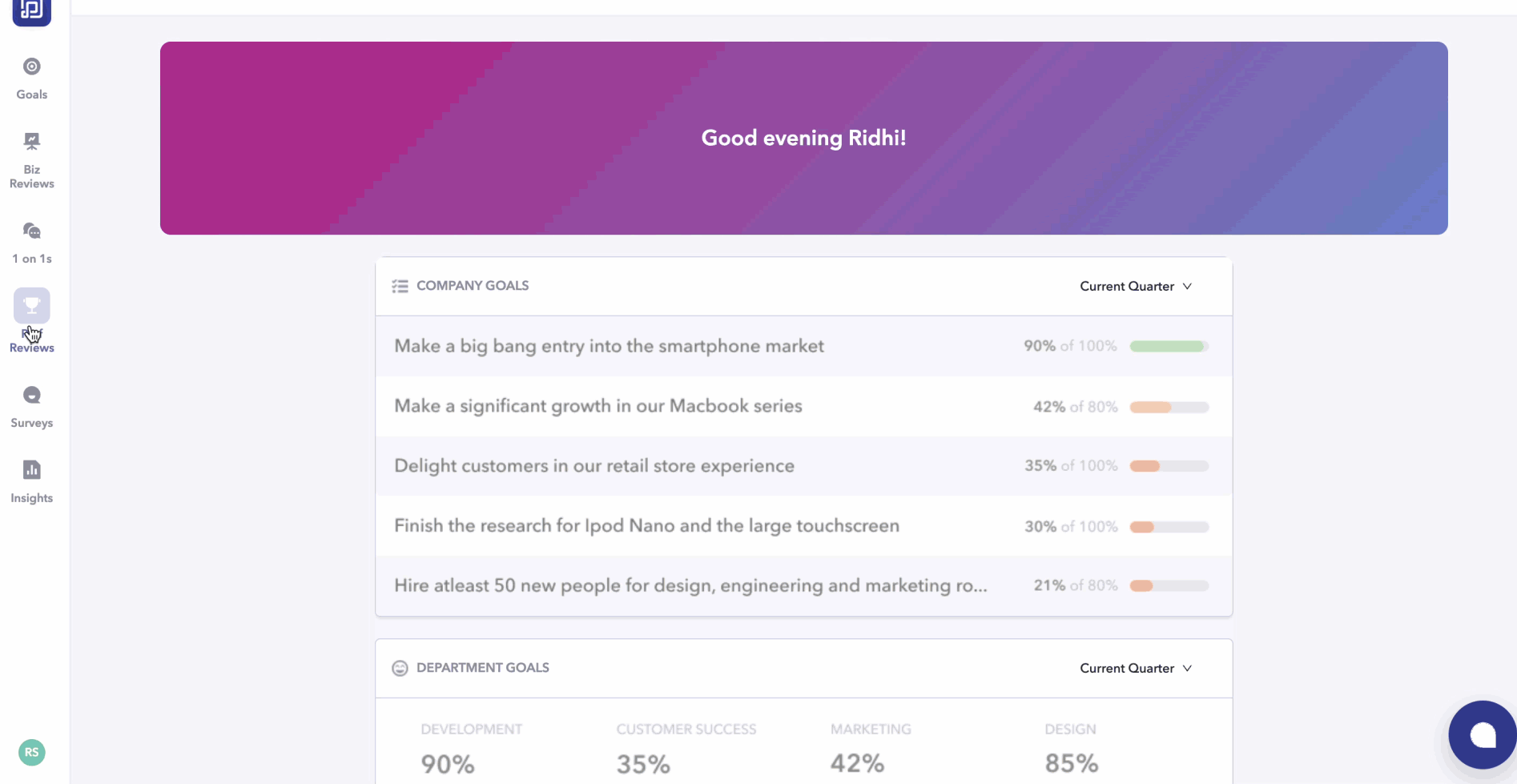
Which Performance Evaluation Method Works Best for You?
With the different methods of performance management available, each with its own unique strengths and limitations, it can get overwhelming to decide on any one or two. To simplify your decision, focus on a few key factors:
Objectives and Focus Areas
What are your main objectives and focus areas for conducting evaluations?
- If development and growth are the priority, then methods providing richer qualitative feedback like 360 reviews may be preferred.
- If compensation determination is the goal, quantified checklist ratings may align better.
- If the organization’s goals are focused on ambitious growth targets across different business areas, and the roles would benefit from being able to tie their work with the bigger picture, then use OKR.
Bandwidth and Resources
Multi-source feedback methods give you more comprehensive insights but require more time and effort to coordinate. Simpler checklists are easier to roll out if bandwidth is limited. Methods relying on external psychologists or assessment centers also have higher associated costs.
Peoplebox removes any need for additional resources by fully automating performance reviews with robust OKR management, 360 feedback, customized evaluations, and real-time survey pulses. Our platform eliminates the manual effort of distribution, follow-ups, analysis, and reporting. What more? You can now conduct seamless performance reviews right within Slack.
Employee Receptiveness
How receptive will your workforce be to different evaluation methods? If transparent culture is limited or trust amongst peers is low, open feedback methods may backfire. Similarly, forced ranking and other comparative approaches could undermine psychological safety.
Organizational Culture
Aspects like your company’s communication norms and level of competitiveness also play a role in the optimal choice. Frequent open dialogue aligns better with coaching-focused methods for example, while incentive-driven cultures may embrace quantifiable achievement metrics more.
Optimize with the Right Systems and Software
How you implement the perfect method of performance management will depend on the size of your organization and the type of people involved, among other factors.
For example, peer reviews may not be the best example for extremely competitive co-workers. Reviews that involve clients may not be the best for companies in industries with clients who expect you to always over-deliver unless you have very receptive employees who would actually welcome that feedback.
Platforms like Peoplebox easily incorporate the different types of performance management methods into your existing workflows with key features that optimize the process, like:
- Automation of cumbersome administrative tasks (like distributing surveys)
- Customizability to tailor methods and criteria
- Condensed, easily scannable talent capabilities and trajectories (like graphs depicting employee progress)
- Real-time goal tracking with transparent OKR dashboards
Ready to supercharge your performance management process? Get in touch with us today!



